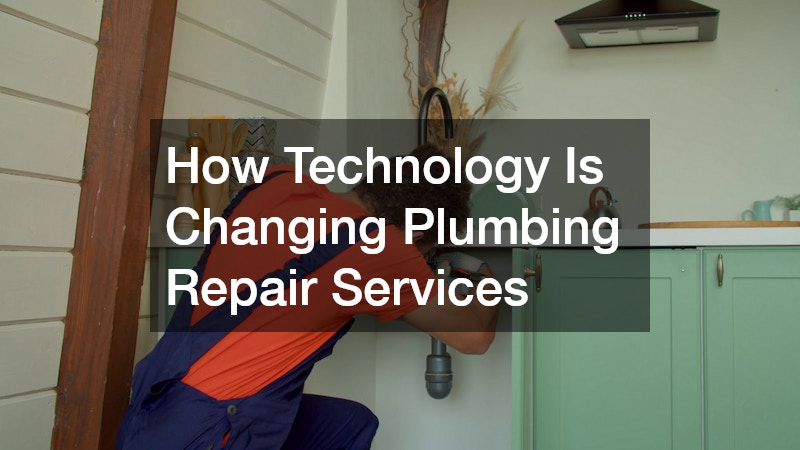In recent years, technology has revolutionized various industries, and the plumbing sector is no exception. This article explores how advancements in technology have transformed plumbing repair services, making them more efficient, cost-effective, and environmentally friendly. By integrating cutting-edge tools and digital solutions, the plumbing industry is now poised to tackle some of the most complex challenges in innovative ways.
The Latest Technologies Being Used in Plumbing Repair
Smart Leak Detection Devices
Smart leak detection devices use advanced sensors and IoT technology to identify leaks early, preventing water damage and costly repairs. These devices monitor water flow in real-time, alerting homeowners and plumbers about potential issues before they escalate.
By leveraging smart technology, plumbing professionals can provide proactive maintenance, thereby extending the lifespan of plumbing systems and reducing water wastage.
Many smart leak detection devices are designed to integrate seamlessly with home automation systems, enhancing their functionality. With mobile connectivity, users receive instant alerts on their devices, enabling swift action to mitigate leaks. This innovation not only fosters peace of mind for property owners but also aids plumbers in efficiently managing their service schedules based on real-time alerts.
The adoption of smart leak detection devices is steadily increasing as consumers and professionals alike recognize their value. According to a recent study, the global demand for smart water leak detectors is expected to grow significantly in the coming years. This growth is driven not only by the need for better water management but also by increasing awareness of technology’s role in sustainable practices.
Hydro-jetting Equipment
Hydro-jetting is a cutting-edge method that uses high-pressure water jets to clear stubborn blockages and maintain clean pipes. This technology is particularly effective against accumulations of grease, scale, and tree root intrusions that traditional methods struggle to address. By utilizing hydro-jetting, plumbers can ensure thorough cleaning without damaging pipes, making it an excellent long-term solution.
One of the notable advantages of hydro-jetting is its ability to restore pipe functionality quickly and efficiently. Unlike conventional augers or chemical cleaners, hydro-jetting removes debris without leaving remnants that might lead to recurrent blockages. This approach not only restores optimal water flow but also enhances the structural integrity of plumbing systems.
As more plumbing professionals adopt hydro-jetting technology, its popularity continues to rise. Hydro-jetting equipment is prized for its versatility, being suitable for both residential and commercial applications. The increased efficiency gained from hydro-jetting can lead to reduced service times and lower labor costs, resulting in more competitive pricing for clients.
How Mobile Apps Assist Plumbing Professionals
Real-Time Diagnostics and Troubleshooting
Apps enable plumbers to conduct real-time diagnostics, access repair guides, and troubleshoot problems efficiently on-site. These digital tools empower technicians by providing instant access to a wealth of information at their fingertips. With augmented reality features, some apps even allow professionals to visualize repairs and anticipate potential challenges.
The availability of mobile applications has bridged the gap between fieldwork and the back office, ensuring that plumbers are well-prepared for any repair scenario. By streamlining access to manuals and service histories, these apps help plumbers diagnose issues faster, reducing downtime for clients. The real-time support garnered from such technology enhances overall service delivery and customer satisfaction.
Scheduling and Customer Management
Mobile applications streamline scheduling, invoicing, and customer relationship management, enhancing overall service delivery. With digital scheduling, plumbing companies can optimize their workforce management by analyzing patterns and adjusting resources accordingly. Automated reminders and confirmations help reduce no-shows, while electronic invoices simplify financial transactions for both providers and clients.
These tools offer a centralized database where customer information and service histories are easily accessible. By having instant access to client preferences and past projects, plumbers can tailor their services to specific needs, improving personalization and customer loyalty. CRM features in these applications foster better communication, ensuring clients are informed at every stage of their service experience.
The Role of 3D Printing in Plumbing Repairs
Customized Repair Parts
3D printing allows for the creation of customized plumbing parts, reducing wait times and ensuring precise fittings during repairs. This technology has enabled plumbers to produce bespoke parts on demand, a critical advantage for repairing outdated or unique systems. By minimizing reliance on supply chains, 3D printing enhances the flexibility and responsiveness of plumbing services.
The precision of 3D printing ensures that components meet exact specifications, reducing the risk of leaks and misalignments. This capability is particularly valuable in historic buildings or customized installations, where traditional parts may no longer be available. Plumbers can now provide a level of customization that ensures repairs are both functional and aesthetically pleasing.
Cost-Effective Solutions
The use of 3D printing in plumbing contributes to cost-effective solutions by reducing the need for large inventories of spare parts. This reduction in inventory not only minimizes overhead costs but also streamlines supply chain management for plumbing companies. By producing parts on demand, 3D printing reduces the need to maintain costly storage facilities.
Additionally, the material cost for 3D printed parts is often lower than those manufactured through traditional methods. The speed of production allows for quicker turnaround times, reducing labor costs and enhancing service delivery. As 3D printing technology evolves, the potential for further cost reductions becomes increasingly feasible, making it an attractive investment for plumbing businesses.
The fusion of technology with traditional plumbing practices marks a new era of innovation and customer satisfaction. The emphasis on efficiency, customization, and eco-friendliness empowers plumbers to set new benchmarks in service delivery. With a forward-thinking mindset, the plumbing industry is well-prepared to meet the evolving needs of both clients and the environment.




